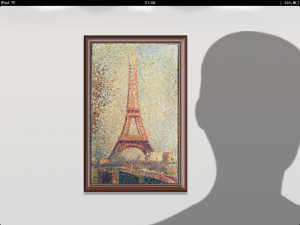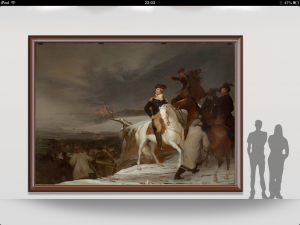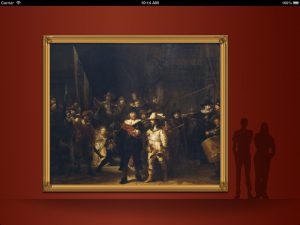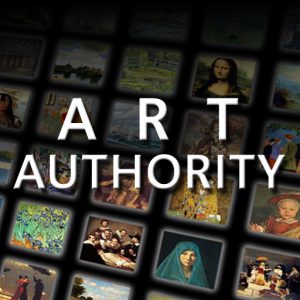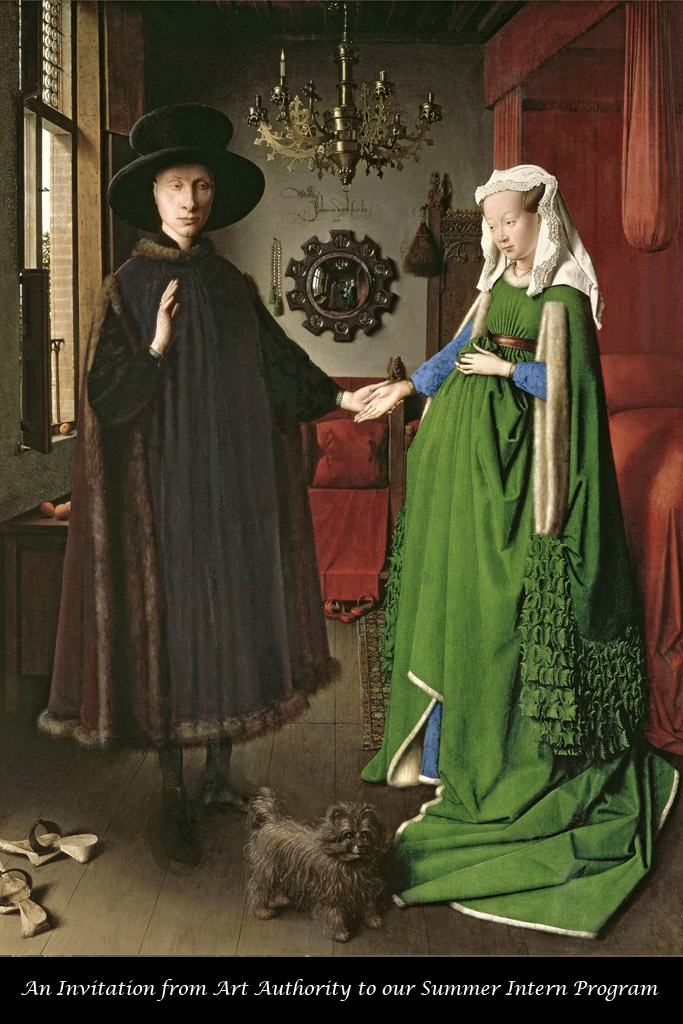Art Authority Blog
Changes in Art Authority for iPad 4.8
Art Authority for iPad 4.8 is a major new release of our #1 classic art viewing app. It adds the groundbreaking “Art Real Size” feature, along with some changes in the way you get around. For long-time Art Authority for iPad users, we thought we’d list the getting-around changes you might want to be aware of. When we went to add the cool “Art Real Size”, we realized that the way people got around within the various “shows” could use some improvement, particularly when viewing framed art (which is where you get to “Art Real Size” as well as “Art Like This”). So we replaced the gear button in that view with a pull-down menu, and made a few other changes as well. Here’s a list:
- The gear button is replaced with a pull-down menu, which is used to get to the thumbnail grid, “Art Like This” and the new “Art Real Size”
- A single tap on the framed work of art also gets you to “Art Real Size”. Another single tap will get you back.
- Double-tap, or pinch-zoom, on the framed work takes you to the full-screen view (even if viewing “Art Real Size”)
- In addition to flicking, you can now go to the previous or next work of art by tapping the very left or very right of the screen (as you do in the iBooks app)
- If you want to go to the first work in a show, tap above the filmstrip and then tap the first image in the filmstrip.
- You can of course push the pull-down menu up out of the way when you’re not using it.
An additional nice new feature in Art Authority for iPad 4.8 is that you can now flick from room to room. So for instance, flick left to go from the main room to the Early room. Then from Early to Renaissance. Etc. Check the Art Authority for iPad Users Guide for all the details of getting around Art Authority for iPad.
Size Matters
Today we’re introducing a new feature in Art Authority for iPad. We think it’s a meaningful and groundbreaking one. It’s called “Art Real Size.”
Traditionally, when works of art are reproduced in books, posters, Web sites and yes, even apps, they’re usually displayed as large as possible. Art Authority, as well as some other sites and apps, have supplemented this type of display with, for instance, a grid of small images (thumbnails) that includes similar works by the same artist or from the same period. Art Authority for iPad also displays the works framed and hanging on the walls of its professionally designed rooms, one of its most popular features.
Until now however, all these different ways of displaying the art overlooked one key fact: different works of art have different sizes. We all showed each work of art at essentially the same size as all the other works. Art Authority for iPad’s 65,000 paintings and sculptures all showed up at about 7 by 5 inches on an iPad in “full-screen view”, 5 x 4 when hanging on a wall, and less than an inch square when in a thumbnail grid. We just haven’t been showing you the whole picture!
It’s true we, and many other sites, have a caption, which might say a work is 182.9 x 243.9 cm, or 9 1/8 x 6 7/8 in. But that really doesn’t mean anything to most people looking at the image, does it? “Art Real Size” gives real meaning to the real size of a work of art.
So how does Art Real Size accomplish its magic? It would be quite a feat to display most works of art real size on a 7 x 5 inch iPad screen (where is that holographic technology from Star Wars when you really need it?). But by adapting an old trick to a new device, we can do almost as well. In this case a picture is probably worth even more than a thousand words, so here are some examples:
We’ve also created a video, worth a thousand pictures.
See how well it works! You now “get” the whole picture. The people viewing the art provide the context needed for our brain to immediately understand the real size of the works. You can see what you’ve been missing! If you had gone to the Louvre and looked at the Mona Lisa, and then walked down the hall to The Raft of the Medusa, you couldn’t have missed this HUGE difference. But if you hadn’t, with just about any other presentation, you wouldn’t have had a clue. That’s what Art Real Size is all about.
And that’s what Art Authority is all about. Making a difference. As the #1 classic art app out there, we’ve been doing that for five years now. Art Real Size is just our latest and greatest.
Art Real Size is available in Art Authority for iPad 4.8, in the App Store today. And it’s on sale for half-price to celebrate! Updates from previous versions are of course free. Check it out, and see how size matters.
Must-See Works of Art at the Louvre, Real Size
Last year, the Huffington post ran an article and slide show celebrating the Louvre’s 219th anniversary. We thought for its 220th (August 10, 2013) we’d take advantage of Art Authority for iPad’s new “Art Real Size” feature to show you what that article, and almost all representation of art to date, are missing.
- Venus de Milo in Art Authority
- Venus de Milo with Art Real Size
- Mona Lisa in Art Authority
- Mona Lisa with Art Real Size
- Liberty Leading the People in Art Authority
- Cupid and Psyche in Art Authority
- Oedipus and the Sphinx in Art Authority
- The Raft of the Medusa in Art Authority
- Milo of Croton in Art Authority
- Louis XIV in Art Authority
- Death of the Virgin in Art Authority
We’ve also posted a similar video.
Envisioning Art Authority: five years later
Five years ago this evening, Apple rolled out the App Store. And Art Authority was there. In a manner of speaking.
When, in early 2008, Apple announced they were going to sell third-party iPhone apps through an “App Store,” we knew we had to make an app. After all, Open Door Networks had been creating Apple software for well over a decade, and the iPhone was incredibly cool.
We immediately partnered with fellow Ashland developer Project A and began brainstorming. No one knew what a third-party iPhone app would look like. We threw around all sorts of ideas, including ones that would probably have made us many millions of dollars (a voice recording app, for instance) and ones that Apple would have nixed entirely (a tethering app, which was perhaps the first app they ever did nix). We settled on an app based on a Mac Web-image browser, Envision, that we had shipped a few years before.
We were very proud that our “iEnvision” Web-image browser was in the App Store on day one, five years ago exactly. iEnvision let users enter URLs and then displayed images from those Web sites full-screen, in automated slide shows. It also included “bookmarks” to five categories of image sites that we thought displayed particularly well on the iPhone: comics, space photos, newspaper front pages, children’s books and… art!
When we checked out the newly opened App Store that evening, we were shocked to see over 500 apps! How well would we be able to compete with such a large number? The answer was very well. Pent up demand, along with Apple’s new iPhone 3G made just about every app available that day a success. iEnvision in particular benefitted from some excellent press (Macworld: “a great tool for browsing large image collections”).
iEnvision was a really good start for us, but it turned out to be a bit complex for an iPhone app. It was quickly clear we needed to simplify. Within a month, we were able to break out the individual built-in categories from iEnvision into individual apps, which we called “Envi apps.” There was “Comic Envi,” “Space Envi”, “News Envi”, “Kid Book Envi” and… “Art Envi.”
Art Envi in particular was a huge hit, especially in Japan where it quickly became the #1 app on the entire Japan App Store. From there we went on to develop over 100 different “Envi” apps, from Harleys through Haircuts, Travel through Teddy Bears. But it was becoming increasingly clear that great art was what people really wanted on their iPhones. And, as the number of apps on the App Store quickly surpassed 100,000, it was also clear we were going to need a really great app to display that great art. So, when Apple announced the iPad in early 2010, it was a no-brainer what we were going to implement there: art, art, art. Art Authority in particular.
We took Art Envi to the next level. Dozens of times the number of artists and the amount of art, many more ways to search and access the art, and a professionally-designed virtual museum interface. The result: “an experience unlike any other” (according to the NY Times anyway). And of course it was there on the iPad’s day one as well. Art Authority, for iPad, iPhone and Macintosh has since gone on to become the #1 classic art app, literally and figuratively changing art history.
And it all started five years ago today. Thanks Apple!
Art Authority goes social
We’ve gone social. With the help of our summer intern class of 2013, Art Authority now has pages up on Pinterest, Instagram and tumblr. We’re using these pages, for now, to feature an “Art of the Day” series, with interesting and relevant works of art from our 60,000+ work database. And of course we’re posting links to these pages on our Facebook and Twitter sites.
Summer Intern Program Class of 2013
Now that most of them have started, we wanted to give a quick update on the current set of interns in year 3 of the Art Authority Summer Intern Program. We have over twenty art and art history majors helping us increase the quality and the quantity of entries in the Art Authority database. There are multiple representatives from Barnard, UC Berkeley, UCLA and Vassar, as well as students from Columbia, Emory, Fordham, University of San Francisco, University of Michigan, San Francisco State and Stony Brook. We also have a representative from the University of Glamorgan, Wales and one from the University of Auckland, New Zealand. All the interns are working remotely from their homes, schools and other locations, making the program even more unique.
This year’s intern program is being managed by an alumna from last year’s program. She’s helping this year’s “class” become familiar with key digital collaboration tools like Google apps, Google groups and Skype, as well as of course the Art Authority database. The interns are specializing in specific artists within the database, becoming expert in those artists, ensuring that those artists’ key works are represented, finding articles about the artists’ works, and checking, correcting, and supplementing other pieces of metadata in the database. They’re also becoming familiar with and adding to our community site.
The program is a great learning experience for all concerned. The interns learn important tools and collaboration techniques and get to understand their artists in depth. We here at Art Authority learn about “issues” with our database and community, and also what it takes to manage a diverse group of college kids working across 14 time zones. We’re also getting new and interesting points of view on various aspects of the art world. It’s going to be a fun summer!
Millais work acquisition shows advantage of art going digital
Earlier this week the Ashmolean Museum announced the acquisition of one of the major works of British Romantic artist John Millais. The 1854 portrait of John Ruskin had previously been in private hands.
Within minutes of becoming aware of the acquisition, we here at Art Authority were able to change the location of the work within our database, and add a link to an article describing the acquisition. So, the same day as the announcement, Art Authority users browsing Millais works, or looking at works from the Romantic period (perhaps through “shuffle”) or even coming across the work through an “Art Like This” search, would get the correct and enhanced information. And Art Alert users, checking out what art they could view in the Oxford area, would see that the work is available at the Ashmolean.
Think how this type of information would have propagated in the pre-digital art world (or, actually, how it will propagate in the remaining part of that world). Catalogs would have to be changed. New revisions of art history textbooks would have to published. Professors would have to change their slides. And the information would still remain inaccurate (will still remain inaccurate) in many places for years if not decades.
But in the new world where art is digital, the change is nearly instantaneous. Art Authority’s president and founder, Alan Oppenheimer, has been giving talks on the many advantages when “Art Goes Digital,” most recently at Macworld/iWorld and Cal State East Bay. It looks like there will need to be a new bullet item added to those talks: the near-immediate update of information when things change!
(Art Authority is of course only one example of art going digital. But we’re proud to say that we even beat Wikipedia with the updated information!)
Art Authority Summer Intern Program, year 3
Today we announced year 3 of our very successful summer intern program. As we discussed last year in this blog, the Art Authority Summer Intern Program offers art and art history majors a 21st century alternative to traditional art docent internships. By working on our cutting-edge app and database, technology-focused students gain experience with and exposure to a set of tools they’ll need as “art goes digital.”
We here at Art Authority have learned a lot over the past two years, both as far as how to run the intern program and as far as what’s needed to keep the app line on top. And it’s been working, as exemplified in Apple’s current Celebrate the Arts campaign.
Students have learned a lot too, gained credit towards their major, and even found jobs as a result of the program (one of them works here!). And of course it’s not just the Art Authority app now, but also Art Authority K-12, Art Alert and community.artauthority.net. Even an iBook. So we’re really looking forward to another great and meaningful summer for all concerned.
If you or anyone you know is curious about the program, please check out the Summer Intern Program Web site for more information and an application form. The number of spaces are limited, so anyone interested should apply as soon as possible.
We celebrate Apple celebrating the arts
The home pages of the various App Stores (iTunes on Mac/PC, iPad, iPhone) currently have a big rotating banner proclaiming Celebrate the Arts with a subhead of “Fine Art, Music & Literature”. If you click/tap on this banner, you are presented front and center (literally in some cases) with our Art Authority app, among others.





